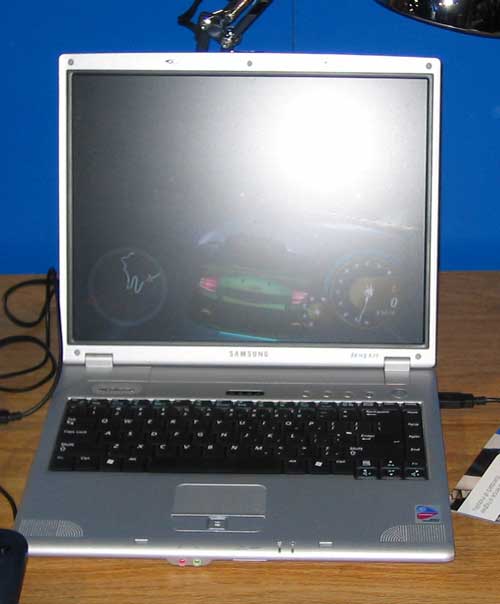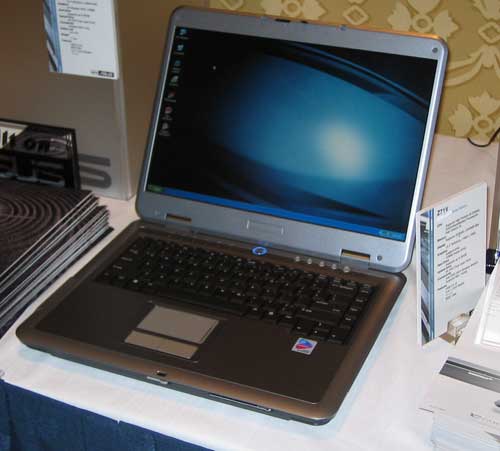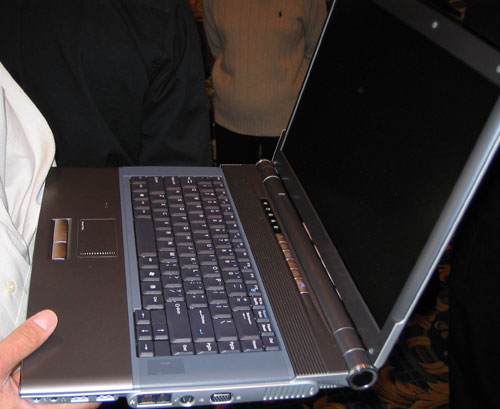Consumer Electronics Show 2005: AT's Coverage
by Anand Lal Shimpi on January 10, 2005 3:49 AM EST- Posted in
- Trade Shows
Intel's Sonoma Platform
Intel's Sonoma Platform, the codename for the soon to be released Centrino update, was also talked about quite a bit at Intel and the show.

Sonoma incorporates the following:
- Intel's Alviso chipset (mobile 915 chipset)
- 533MHz FSB Pentium-M processors
With the new chipset comes improved integrated graphics (thanks to the 915G's integrated graphics core), dual channel DDR1/DDR2 support, 533MHz FSB support, PCI Express support and HD Audio support.
The chipset offers both PCI Express x16 and x1 support for graphics and peripherals, identical to the desktop 915.
The inclusion of dual channel DDR1/DDR2 support is tremendous for performance as the previous generation 855GME chipset was still only a single channel platform for Centrino. Intel stated that going forward the split between DDR1 and DDR2 Sonoma designs is about 50/50, given that the power requirements of mobile DDR2 and mobile DDR1 are quite similar. The platform supports up to DDR2-533, but we'd expect that fewer companies would use the speed just yet. We asked some memory manufacturers and they seemed to think that a 50/50 split between DDR1 and DDR2 Sonoma platforms (based on their shipments of DDR2 to Intel's customers) would be definitely possible by this summer.
Intel will also be releasing a smaller form factor version of the Alviso chipset with a much smaller package for use in very tiny ultra portable laptops. The smaller version of the chipset will lack a PCI Express x16 interface to reduce pin count and may only be single channel.
None of the Sonoma platforms on display were too impressive, but we did see units from ASUS and ECS among the usual suspects.

ASUS' Sonoma platform
ECS had a large footprint but cool-looking Sonoma notebook:


Reasonably thin considering its footprint

...and interestingly textured
Battery life is expected to be similar to current Centrino designs.










48 Comments
View All Comments
quanta - Wednesday, January 12, 2005 - link
Isn't DLP design rather unreliable? After all, it involves mechanically moving millions of microscopic mirrors to create brightness, and there is no easy way to oil these tiny joints when the chip gets old. Since each mirror is moving thousand of times a second, dead pixels can develop rather quickly. As a side effect of moving all these mirror, won't the chips get noisy as well?PrinceGaz - Wednesday, January 12, 2005 - link
Heh, as soon as I read the bit about mobo manufacturers confirming what most of us already know; that nVidia has abandoned SoundStorm and it will not be returning in anything like its original form (DD encoding) in the forseeable future.Just because the Inq reports on something doesn't make it gospel truth, much of what they post is rumours and they have been known to be wrong in the past ;) As for the nVidia chairman saying SS is returning in a surprising form, that could mean just about anything except what some people here are hoping for. A return of the original SS or an updated version of it would be totally unsurprising so he is effectively ruling that out.
Could one of the SS zealots who believes it will make a return with PCIe please explain to me why it needs more bandwidth than what PCI can provide? Surely if the card is doing all the encoding, all that needs to be sent to it is the raw audio data which is minimal. Even the very highest quality 8-channel 32-bit 192khz sampling-rate uncompressed audio needs under 6MB/s of bandwidth which is easily handled by PCI, so I fail to understand why PCIe would make a difference. If there were sufficient consumer demand for a DD encoder, somebody would have already made one for PCI, so you're deluding yourself if you think the only reason they aren't available is that it needs the increased bandwidth offered by PCIe. Unless of course you have evidence which suggests otherwise and I'd be interested in reading it.
Rather than waiting for the return of SS, I suggest you buy a few decent cables and hook up your soundcard to your amplifier the normal way. Provided the soundcard has decent DACs, you'll enjoy higher quality sound than anything SoundStorm's dolby-digital output could provide.
linuxOwnzIfUrLeet - Tuesday, January 11, 2005 - link
#44,45...It's at sam's club:
It's made by infocus.
The web shows "InFocus® ScreenPlay 4805" but I'm not sure the 4805 was the one. Their web is not the same stuff as what you have in the store.
bob661 - Tuesday, January 11, 2005 - link
#44I was going to ask the same thing.
#39
SS is dead. Move on, nothing to see here.
OrSin - Tuesday, January 11, 2005 - link
14# Where can I get a 76 DLP for 1400.Shit where can I get decent 76" HD of any kind of for $1400. I live in the USA. I really want to know. My 42in Toshiba HD is not cutting it and it cost me $1000.
xxeper - Tuesday, January 11, 2005 - link
I love how you talk about how "bulky" the Windows Mobile [PocketPC, MPx] are while at the same time basically petting and licking the Windows Mobile smartphone [C500]. Did you even bother to pick up the BENq or iMat Jam phones? or were you too busy whispering sweet nothings to your P.O.S. Audiovox?Live - Tuesday, January 11, 2005 - link
#13The X800 you are linking to costs 450$ when its supposed to sell for 250$. and only that brand is available.
Zebo - Tuesday, January 11, 2005 - link
AMD was curiously quiet throughout the show,----------------
Speak Softly and carry a big stick.:)
RyanVM - Tuesday, January 11, 2005 - link
#9, I read the exact same thing in Maximum PC three months ago.shinotenshi - Monday, January 10, 2005 - link
The design team was disbanded, however many sources have already reported that the team was reconstitued. The design won't be finished by luck would have it, at the time the sony ps3 is done. As i said before, i don't this is a coincidence. the interest of sony(ps3,blu-ray) and nvidia(pushing pci-e, other markets, consumer, pci-e sound cards), are converging. If they can build a chip that can encode either DD++ or DTS+++ it would be an econnomic windfall.